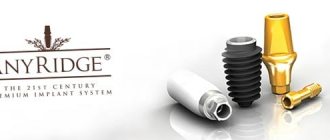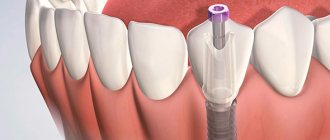Today, the attitude towards implantation has become simpler than it was ten years ago. However, the insufficient bone volume for implant placement, which requires bone grafting, changes everything. Many patients categorically refuse additional surgery, preferring other prosthetic methods. However, some techniques make it possible to do without bone grafting even in the most difficult cases. The chief physician and leading specialist of the Professorial Dentistry “22nd Century” in Moscow Arkady Aleksandrovich Snitkovsky talks in more detail about such methods.
Is implantation possible without bone grafting?
Today, there are the latest foreign developments in this area - implantation according to the Frankfurt protocol in the complete absence of teeth, as well as special implants that can be used without first replenishing the volume of the jaw bone in 90% of cases. When a patient has narrow bone, a splitting technique can be used to allow the implant procedure to be performed without bone grafting. Thanks to this technique, the patient receives a finished prosthesis within 3-4 months. While with classical implantation technology with preliminary surgery to increase bone volume, tooth restoration is often delayed for 10–12 months. Thus, the splitting technique avoids invasive procedures such as transplantation of bone blocks taken from other parts of the jaw. In addition, there will be no need for subsequent correction of soft tissues, which is necessary after bone grafting, as a result of which the gum is greatly stretched, which often leads to exposure of the transplanted bone block or implant.
In what cases is bone augmentation necessary?
Refusal of bone grafting in some situations does not guarantee the success of implantation
Osteoplasty cannot be avoided if:
- extreme bone deficiency in height and/or width;
- advanced stages of periodontitis with loss of bone tissue.
Implantation in such cases can lead to serious complications:
- perforation of the maxillary sinus in the upper jaw with the development of an inflammatory process and odontogenic sinusitis
- damage to the jaw nerve of the lower jaw with numbness of the lip and lower face
- displacement and, as a result, rejection of the implant with inflammation of surrounding tissues
Installation of an implant using the splitting technique
Using a special instrument whose action is based on microvibration (somewhat reminiscent of the effect of ultrasound on tartar), the doctor carefully and non-traumatically makes a small incision in the bone. A special screw implant is installed in it, designed in such a way that it itself splits the bone ridge and increases the total volume of the bone. Unlike surgery using bone blocks, in this situation, specialists perform only one procedure. When plastic surgery with bone blocks is required, at least three operations are required: taking a bone block and transplanting it onto a narrow bone ridge, after 6-8 months - installation of implants, and also after another 3-4 months - gum plastic surgery, which, in turn, will continue to heal 2 months. Splitting the bone during implantation often makes it possible to avoid these lengthy procedures.
How is the operation performed?
Before the operation, a thorough examination of the patient is carried out, aimed at assessing the clinical picture, as well as eliminating possible contraindications. To this end:
- Laboratory blood tests, radiography and CT scans are prescribed.
- A plan for the operation and the area for introducing artificial roots is drawn up.
- The oral cavity is sanitized and professional hygiene is carried out. These manipulations reduce the risk of side effects.
On the appointed day, the operation is carried out according to a certain algorithm:
- Anesthesia.
- Dissection of soft tissues and creation of access to the alveolar process.
- Detachment of the mucous flap.
- Formation of a bed for implantation and bone material.
- The surgical area is covered with an insulating membrane, which helps to securely hold the bone material.
- The mucous membrane is sutured.
After the operation, the doctor talks about the rules of care after the operation. Following them will help reduce the risk of complications:
- Observe hygiene rules.
- Eliminate stress on the surgical field.
- Complete cessation of bad habits.
- Limiting intense physical activity.
- In the first 2-3 weeks it is forbidden to visit the sauna or bathhouse.
Features of implants
When implanting using the splitting method, screw implants of a special design are used. They have a cone-shaped body, thanks to which they easily enter the bone, pushing its edges apart, like a wedge. However, the wedge is easy to knock out, so the conical shape of the implant is combined with a cylindrical thread profile, which allows it to be firmly fixed in the bone tissue. This unique feature of such implants gives doctors the opportunity to install them in narrow bones without undergoing bone grafting. They smoothly screw into the gap between the bone walls through a hole measuring only 2 millimeters and do not damage them. In addition, the sharp thread of the screw implants and the wide spaces between the turns of the spiral, through which bone tissue quickly grows, contribute to faster stabilization. Thus, after three, maximum four months, permanent crowns can be installed.
Basal implantation – what is it?
The method began to be actively used by dentists more than 30 years ago, all the time continuing to develop and improve.
Implantation using this method involves the use of screw implants. The technique makes it possible to make maximum use of the available bone tissue of the patient, which allows not to resort to additional surgical intervention, and also significantly saves money and time.
How many lost teeth can be restored this way?
The technique makes it possible to restore any number of lost teeth. Even when implanting one tooth, technology allows an incision to be made in such a way as to insert the implant into the bone without damaging the adjacent teeth. But most often, a narrow bone occurs in the absence of a large number of teeth, so specialists usually install two to four implants on each side.
Make an appointment
right now!
Snitkovsky Arkady Alexandrovich
Therapist, Orthopedist
Disadvantages of “boneless implantation”
The survival rate of basal implants is close to 100%. The likelihood of inflammation developing around the basal implant is almost zero. There are practically no disadvantages to this method! We provide unique guarantees for our work.
Our warranty obligations:
- free preventive examinations, bite correction, reshaping of teeth and artificial gums (if necessary) - during the first year;
- free repair or alteration of the prosthesis (at our choice) in case of its breakage or de-cementing - during the first year;
- free removal or replacement of the implant (at our choice) in case of its rejection, and the associated correction or alteration of the denture (at our choice) - during the first year;
- refund of 50% of the money paid and removal of the entire structure, in case of failure (God forbid!) and the patient refuses further attempts at prosthetics on implants - within the first year.
- replacement or installation of an additional implant at cost (currently 5,000 - 10,000 rubles) - from the second to the tenth year.
Of course, all of the above obligations will be valid only if the patient regularly visits our clinic for the purpose of preventive examination (according to the approved schedule), the patient’s compliance with oral hygiene and all our recommendations.
Additional Information
- Here you will find more complete information about basal dental implantation (technology, prices, photos, documents)
- This page contains real photos and reviews from our clients.
- Here you can make an appointment with our professional dentists.
Is implantation always possible without bone tissue augmentation?
Typically, the jawbone is oval in shape. Then, during the process of atrophy, only its upper part on the buccal (front) side loses volume, while its base remains wide and supports the rest of the bone. In this case, we can safely carry out “splitting” and not be afraid that the bone will break. However, if the ridge lacks thickness along its entire length, or is less than two millimeters, bone grafting is necessary. True, such situations are quite rare, and in these cases doctors are forced to follow the classic path - performing plastic surgery using bone blocks.
Do mini-implants and all-on-4 implants help avoid bone grafting?
Mini-implants can only be used as temporary structures or to fix a removable denture. If the prosthesis rests on such implants, they will be rejected. Therefore, when implanting all on four, standard size implants are used.
The All-on-4 or All-on-6 techniques allow you to place a permanent prosthesis on implants, most often with screw fixation. Only a very experienced doctor should install an orthopedic structure, since even a slight error in calculations can lead to improper distribution of the chewing load and cause implant rejection. With all-on-four implantation, implant placement can also be done using the splitting method. This is a simple and effective procedure that is absolutely safe for the patient and avoids bone tissue buildup.
Why you shouldn't be afraid of the procedure
Some patients refuse to have implants installed if, based on the results of a preliminary examination, they are told that they cannot do without bone augmentation. The main reasons are myths that are based on fears, lack of information, and studying incomprehensible publications on the Internet.
Myth 1. It's painful and scary
The anesthesia may not work, it will be painful, and there will be swelling after the operation.
- Causes of Pain during and after surgery are directly related to osteoplasty technologies. Traditional surgery using a hammer, chisel and other “punitive” instruments does require increased anesthesia during the operation and often causes pain and swelling afterward.
- Reality Our Center uses our own low-traumatic ultrasound protocol . Piezosurgery significantly reduces the trauma of the operation, the device delicately affects bone tissue, and turns off when approaching blood vessels, nerves, and the lining of the maxillary sinus. The operation in a state of medicated sleep using a combo protocol of sedatives and anesthetics eliminates pain and nervous tension. A rehabilitation complex, including microcurrent and PRP therapy, injections of lymphatic drainage drugs, completely relieves post-operative discomfort, including cosmetic discomfort.
Myth 2. It takes a long time
The implantation time will increase because you need to wait for the bone material to engraft.
- Causes Critical bone loss does require a two-step procedure. The operations are divided by time - first bone grafting and several months for the bone to mature enough to support the implant, only then implantation.
- Reality It is impossible to neglect this moment. But bone tissue augmentation and implantation can be carried out in one stage , if the volume of preserved bone allows it. New bone tissue will form simultaneously with the healing of the implant.
Myth 3. It's traumatic
It is necessary to take the bone for transplantation from another area of the jaw in order to transplant it to the implantation site.
- Reasons Indeed, there is a protocol when one’s own bone tissue is used as a material for grafting. It is necessary to further traumatize the patient and perform another operation to remove material from the area behind the wisdom teeth or chin.
- Reality This method is not used in modern dentistry and in our Center. We use biocompatible bone grafts and growth stimulants , which trigger processes that cause bone cells to grow and thicken. The new volume fuses with its own bone, forming a single mass.
Myth 4. It's unethical
Bone tissue from other people is used for transplantation.
- Reasons Yes, previously materials of allogeneic origin were used, which were sterilized and processed many times during the production process.
- Reality We do not use bone materials from other people , since it is impossible to track the degree of purification, the absence of proteins or genes of another person that act as allergens.
What if not only the thickness, but also the height of the bone is not enough?
In this case there are also several options. If the bone height is not enough in the lateral parts of the upper jaw, a sinus lift should be performed. If the bone height is at least 4 millimeters, we can increase the volume of bone tissue while simultaneously installing a high-quality implant. If it is less than 4 millimeters, then after sinus lift you will have to wait 5–7 months before implantation. But if the bone is wide and its height is 5-6 millimeters, then you can do without a sinus lift - here they use short implants with strongly protruding threads. Due to their large surface area, these short but wide implants can withstand the same load as conventional ones.
Types of implantation without osteoplasty
The first and most optimal option for implanting an artificial tooth root without plastic surgery is if the patient’s bone tissue is in ideal condition. In this case (depending on the indications and wishes), classical two-stage technology or one-stage technology can be used. With a two-stage method, at the first stage the implant is integrated and 3–6 months are waited for the completion of the osseointegration process; at the second stage, the gum is formed and a permanent prosthesis is installed. When implementing a one-stage option, all manipulations are performed in one surgical intervention. You can read more about this in another article on our website.
Insufficient volume and size of bone tissue is an indication for osteoplasty. But in some cases it can be avoided. Let's consider the options:
- if the alveolar ridge is narrow and of sufficient height, install implants with a smaller diameter than the standard size;
- if the height of the ridge is insufficient (less than 5 mm) and its normal width, fixation of an implant shortened in height with protruding threads;
- in case of atrophy of the alveolar ridge tissue - the use of the basal technique with the introduction of a titanium root into the deep basal layers;
- with simultaneous tooth extraction and implant installation. With this option, the tissue has not yet undergone loss, so there are no restrictions on the operation;
- when completely edentulous prosthetics are performed using the “All on 4” or “All on 6” method (the jaw prosthesis is installed on four or six implanted implants). The technology involves selecting optimal fixation points for titanium roots in areas that are most suitable for their installation and inclined positioning of integrated titanium rods;
- with a narrow ridge, use the splitting method (intercortical osteotomy). Its essence is that a specially shaped implant, when screwed in, splits the ridge without damaging it, but is securely strengthened there.
Important: implantologists of the “Smile” clinic network have the technology to install implants of any size and with any features. At the same time, doctors use implantation systems only from reliable and proven brands.
What determines the healing time of implants?
It is known that classic root-shaped implants take root on the lower jaw within 3 months, and on the upper jaw within 5-6 months. The timing depends on the primary stabilization, that is, on how tightly the implant was fixed in the bone during its installation, and on the density of the bone. In hard bone, the implant receives good initial stabilization and can be loaded with a temporary crown after only 3 months. If the bone is soft, it is necessary to postpone prosthetics for a longer period, otherwise the implant may be rejected.
With the advent of an implant system with large threads, it became possible to speed up the healing time in soft bone, since it increases the area of contact between the implant surface and bone tissue, and therefore contributes to more durable stabilization. In both soft and hard bone, the healing time of such an implant is about 3 months.
Examples of work “Before” and “After”
Basal implantology with immediate loading
Case: The patient complained of an uncomfortable removable denture.
Restoration of all teeth on the upper and lower jaw - basal implantation
Case: partial absence of teeth on the upper and lower jaws, complicated by a severe form of periodontitis (tooth mobility).
Restoration of all teeth in 4 days - basal implantation
Case: Absence of all healthy teeth on both jaws.
Restoration of all teeth using basal implantation method (March 2012)
Case: partial adentia, exposed roots of natural teeth, periodontitis, increased tooth mobility, severe atrophy of bone tissue in some places beyond the possible norms for classical dental implantation.
Cost of the procedure
The price of the procedure consists of the cost of the implant, the doctor’s work, as well as the cost of temporary and permanent prosthetics. Due to the fact that specialists do not perform bone grafting, the price of implantation, of course, decreases, but not much. This technique was created not to save on implant installation, but to avoid additional surgery in cases where this is possible.
For example, if the bone volume is sufficient and its condition is ideal, you can install any modern implant - it will take root and function for a long time. But if it is necessary to carry out a sinus lift simultaneously with implantation, it will be necessary to use implants that are fixed even in 1-2 millimeters of bone. But if the bone is narrow, the best option would be to use the splitting technique followed by installation of an implant with a wide thread. Everything is fair here - the doctor does not focus on your wallet, but advises and selects the most optimal treatment plan in accordance with the specific clinical situation.
Publisher: Expert magazine about dentistry Startsmile.ru











